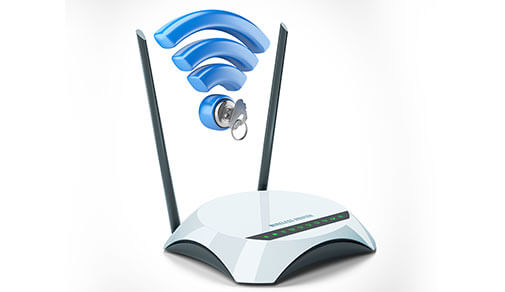In this day and age, quick and consistent connectivity is not a luxury but a necessity. Whether you are at home or working from office, a good WiFi connection is a must.
We have listed some blogs to help you choose the best home WiFi. We also have provided tips on how to manage your home WiFi so that there are no issues with your connectivity. In the blogs, we also look at how WiFi broadband plays an integral role in our lives and how ACT Fibernet is working towards reducing the digital gap in our country.
In this day and age, quick and consistent connectivity is not a luxury but a necessity. Whether you are at home or working from office, a good WiFi connection is a must.
We have listed some blogs to help you choose the best home WiFi. We also have provided tips on how to manage your home WiFi so that there are no issues with your connectivity. In the blogs, we also look at how WiFi broadband plays an integral role in our lives and how ACT Fibernet is working towards reducing the digital gap in our country.
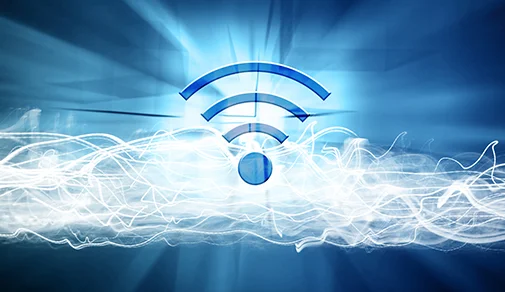
Historically, schools have been the learning repositories - identically it has also been the chief beneficiary of high-end investments such as digital programs, resources, and infrastructure. So, funding has been aimed at the Internet for School along with other digital interventions. But digitizing the school infrastructure and providing online resources are just part of a bigger puzzle - where the only binding element is the School wifi connectivity.
How has technology enhanced the learning curve?
Teachers often have to deal with the futility of technology equipped class where the choices of technology implemented leads to certain challenges, especially if the internet is not up to the mark. To enable a blended learning environment, re-calibration is required where vanilla corridor wifi won’t make learning experience smoother but will debilitate the whole point of digitized learning. Then comes the stage where authentic ways are being charted out to focus on specific goals and how the school can squeeze out the maximum potential of the technology involved.
Here's how schools are leveraging technology-assisted learning inside a classroom:
Digital Learning Drive
The recently used technologies integrated in schools are digital boards, digital library, digital labs, computer labs et al. All of these technologies are driving the learning force in schools with easy and fast access to knowledge and information.
Enhancing Collaboration
Edmodo and Google Classrooms are some of the most frequented digital tools teachers are using to curate and distribute resources. The same can be used for posting updates, announcing class events, and answering any student queries.
Fostering Discussions
Educators have been taking the help of tools like Synth and Padlet to find alternative ways for students to engage beyond the classroom. Synth, for instance, is a tool for podcasting which the teachers are using to provide supplementary resources or making announcements.
 Looking for an internet plans that
Looking for an internet plans that
offer 24x7 assured speeds?Connect now to get the best of broadband plans and get additional offers on:






Switching to Visual Presentations
Visuals and infographics can be used by teachers to chart their course while the students can use the same resource -share it amongst the class and create a collaborative environment.
Benefits of Business Wifi Solution for schools
Now that you have seen how technology is being used to harbor a positive impact on e-learning at schools, the technology will only be useless if there is a lack of seamless wifi for school. Just like business wifi connections that require faster load time and seamless operation, the IT environment of a school requires the same standards.
So, let's chart out the benefits of a WiFi-enabled e-learning environment in schools
Access and Equity -
Distribute and re-calibrate the digital divide that can offer internet access to students who don't have resources to afford the internet otherwise.Security -
Business Wifi follows security protocols that can provide students and faculty member against cyber attacksReformed Pedagogy -
With all-around-the-clock internet at school, the teachers can make full use of the technologies in school, providing all the resources required for holistic learning.Optimized Cost -
School admins can opt for scalable internet packagesSupport -
Expect 24/7 online or offline support
ACT Enterprise is here to help you
If your school is planning to implement a wireless internet solution or pondering about the pros and cons - just get in touch with ACT enterprise and we will get back to you. We'd be happy to assist your school in this makeover including the installation nuances, e-billing options, and other supplementary services.
Contact us to get more information regarding Wi-Fi solutions in schools and how you can keep your students engaged and connected.
Read tips and tricks to increase your wifi speed here
Be Part Of Our Network
All Categories
- BUSINESS INTERNET
- Router
- Internet Security
- Wi-Fi Connection
- Wi-Fi Network
- Internet Broadband
- smartfiber
- Internet Speed
- TV Streaming
- Wifi Connection
- BEST BROADBAND PLANS
- BROADBAND PLANS | 5GHz
- 2.4GHz
- 5GHz frequency
- 5GHz WiFi frequency
- 2.4GHz frequency
- LDRs
- LONG DISTANCE RELATIONSHIP
- ACT Fibernet
- wifi as a service

Find the perfect internet plan for you!

Wi-Fi is wireless LAN and it is accepted as one of the useful technologies of computer networking. It has just changed the way of data transfer and communication. Wi-Fi does not actually stand for anything but from the term, we get a sense of local area wireless technology.
What is WiFi and How it Works?
WiFi works in the way other wireless devices work. It actually uses radio frequencies to deliver signals between devices. But here the radio frequencies are completely different from car radios, walkie-talkies, cell phones, and weather radios. By using radio waves, it provides wireless high-speed internet and network connections. Wi-Fi is a trademarked phrase and it means IEEE 802.11x.
How does Wi-Fi work- firstly, a computer’s wireless adapter translates data into a radio signal and easily transmits it using an antenna. After that, a wireless router receives the signal and decodes it. The router is there also to send information to the internet using a wired Ethernet connection.
What is the difference between WiFi and the internet?
Wi-Fi is just an attractive term used to refer to wireless networks. Previously, there was the only way to connect devices and the way was network cables to create a local area network. It was inconvenient. But Wi-Fi lets one connect one device to another without cables. Without any physical connection, you will get the network. The router mainly controls these connections. One device communicates with another device through the router.
The internet is known as a wide area network or WAN. It is a vast network linking computers around the globe. After connecting your own wireless network, you will become a part of one huge global network. And it is called the internet.
Do I need a modem for Wi-Fi?
A Wi-Fi router is able to work without a modem. The router is there to provide a Wi-Fi connection to the devices along with IP addresses. In this way, you can easily, send files from one computer to another computer, send a stored video from your phone to TV or Chromecast and even print files.

offer 24x7 assured speeds?
Connect now to get the best of broadband plans and get additional offers on:
What is the difference between a Wi-Fi router and a modem?
A router is there to connect multiple networks and route network traffic between them. In this way, the router needs to have one connection to the internet and one connection to the private local network. Most of the routers come with built-in switches and it helps in connecting multiple wired devices. Many routers come with wireless radios that easily let you connect Wi-Fi devices.
On the other hand, a modem works as a bridge between a local network and the internet. Previously, modems were used to modulate the signals on the telephone lines to encode digital information, transmit them, then demodulate and decode on the other end. Modern modems do not work in the same way. According to the type of connection, a modem gets attached to your network. Modern modems are there to give you a standard Ethernet cable output. To properly communicate with your internet service provider, you will need the right type of modem that matches your ISP’s infrastructure.
What do I need WiFi for? [Do I need WiFi for Netflix]
In order to establish Wi-Fi in your home, you will need either a modem connected to a wireless router or a wireless gateway. You can get wi-fi without having an internet service. Devices that provide wi-fi signals for other devices to connect with, can run without an internet connection.
Wi-Fi is not a mandatory thing to enjoy Netflix. Here internet connection is mandatory. With the help of any broadband connection, you can browse Netflix and watch videos.
Day by day, the popularity of Wi-Fi is getting high. It is cost-effective, convenient, and easy to avail. In this way, one can access the internet even outside their regular workplace. Navigation does not affect your productivity if you have Wi-Fi with you.
Read tips and tricks to increase your wifi speed here
Be Part Of Our Network
All Categories
- BUSINESS INTERNET
- Router
- Internet Security
- Wi-Fi Connection
- Wi-Fi Network
- Internet Broadband
- smartfiber
- Internet Speed
- TV Streaming
- Wifi Connection
- BEST BROADBAND PLANS
- BROADBAND PLANS | 5GHz
- 2.4GHz
- 5GHz frequency
- 5GHz WiFi frequency
- 2.4GHz frequency
- LDRs
- LONG DISTANCE RELATIONSHIP
- ACT Fibernet
- wifi as a service

Find the perfect internet plan for you!

The coworking industry is mushrooming with such rapidity that it is getting hard to keep track of the potential spaces popping up each year. With a concept so perfect for the Millenials, co-working space has mustered a sweet corner for the large and medium-scale enterprises.
What is fueling the co-working industry?
But what exactly is fueling this rapid growth? In the context of India which happens to be the third-largest startup hub and the second biggest pool for the freelance workforce, there is a potential demand that is cropping up the need for co-working spaces. With a workforce that comprises 46% of Millenials in India, there is a requirement for collaboration, affordable infrastructure, and a self-sustaining IT ecosystem.
But coworking is not a panacea since there are problems which often hinder the workforce - one of them being the lack of proper high-speed internet. So, with an estimated number of 26,000 coworking spaces looking to pop up by the year 2022, let’s see how a shared working space internet can help you gain a competitive edge in the coworking market.
How can you optimize your co-working space?
Technology has made some pertinent promises in the field of work - from AI-enabled workforce to VR spaces, IT ecosystem has managed to remain the ebb and flow of every enterprise. That’s the kind of anticipated future we are preparing ourselves and so are you. Here are some important trends that have become the driving economy of sustenance, especially in the context of coworking spaces.
Faster and healthier internet
To maintain the hygiene of workflow, WiFi for coworking space is a requirement. In the uber-connected space of coworking habit, the foundation of such a work model lies in the hands of reliable and fast wireless connectivity.
Increase of scaling
By the projections made earlier, coworking spaces will require agility - WiFi plans need to be more scalable. For instance, turnkey solutions like Managed Wifi can allow easy scalability via monthly subscription. This will make space for mid-contract changes and quick refreshes with uninterrupted services across several locations.
Reliable Service and Zero Interruption
In any coworking environment, the members need quick and easy access to internet services and cloud-based applications. So, uninterrupted access is a high priority which is instrumental to respective businesses and products. With premium grade high-speed connectivity, coworking spaces will alleviate unwanted stress and outages.
 Looking for an internet plans that
Looking for an internet plans that
offer 24x7 assured speeds?Connect now to get the best of broadband plans and get additional offers on:






More Bandwidth
Bandwidth is the speed and the type of your internet service. When everyone is paying, they’ll obviously expect equally distributed internet speed. Your bandwidth should be such that it can sustain all the member connected to your IT environment. If you have 10 members with 5 active members on site, the bandwidth should be such that it supports 7 members.
Multiple Access Points
Access Points are hardware units that is used for wireless device connectivity. Since BYOD is an existing culture in co-working spaces, users tend to bring a range of mobile and wireless devices that requires access points to connect to a wired network. Depending on your space, distribute your access points such that it covers all potential users.
Network Security
Create a separate wifi network for your guests and add a second layer of network security for your existing wireless network.
High Quality Hardware
Even if you are looking for a reliable internet service provider, don’t compromise on the hardware quality. Make sure to buy routers and associated devices that can sustain your upgraded bandwidth plans.
How can fast internet connectivity be a game-changer for your co-working space?
Coworking space is more than just providing a chair and a desk - it's about maintaining a collective balance. Beyond its ambiance, comfort, accessibility, and convenience - the foundation of such connectivity and collaboration lies in the power of your internet connectivity. So, let's have an overview of how a reliable high-speed internet connection can end up being a game-changer.
- Enhanced efficiency to sustain technology-driven choices
- Faster internet for everyone with unlimited usage and capless bandwidth
- Optimum cost with more flexible subscription plans.
- Future Proof for a better tomorrow.
Are you ready for the future?
With a high-speed internet connection, you can deploy cutting edge technologies to equip your business. So, if you are looking to scale business and increase profitability by leveraging the potential of cutting edge technology, then check our plans for a future-proof upgrade.
Be Part Of Our Network
All Categories
- BUSINESS INTERNET
- Router
- Internet Security
- Wi-Fi Connection
- Wi-Fi Network
- Internet Broadband
- smartfiber
- Internet Speed
- TV Streaming
- Wifi Connection
- BEST BROADBAND PLANS
- BROADBAND PLANS | 5GHz
- 2.4GHz
- 5GHz frequency
- 5GHz WiFi frequency
- 2.4GHz frequency
- LDRs
- LONG DISTANCE RELATIONSHIP
- ACT Fibernet
- wifi as a service

Find the perfect internet plan for you!

It has become extremely important to have access to high-speed internet at all times. Be it for personal browsing and video streaming, or for a work from home set up with professional video conferences every other hour, we need a stable internet connection at home. As such, a perfectly functioning and secure home WiFi network is the need of the hour.
WiFi plans will be of no use if we do not set up a home network in the right way. Setting up a home WiFi network is not too difficult. The following steps explain the process in a simple and easy way:
Get the right router
The very first step in setting up a home WiFi network is to get the right router. It is important to take into consideration factors such as the probable distance between the router and the devices connected, the interference levels based on the number of devices operating nearby, the transfer speed required, and security. It is best for the router to have the latest form of wireless encryption which is WPA2.
Connect the router to the modem
Next, the port on the router that is labeled WAN/WLAN/Internet is to be connected to the modem using an Ethernet cable. The router should be switched on.
Connect the computer with Ethernet cable
Though not always necessary, connecting the computer’s LAN port with an Ethernet cable helps to configure the wireless WiFi settings without running the risk of losing the connection to the router.
Install router software
If the router comes with software, users should install it on the computer. Users should then choose and enter a name for the home WiFi network, the type of security, and a complex password.
Open configuration page
In case the router does not come with software, users need to connect the router’s configuration page through the web browser. The web address of the router is to be entered on the web browser. This is provided in the manual or documents that come along with the router. The username and password are also to be entered. These details are provided in the manual.
 Looking for an internet plans that
Looking for an internet plans that
offer 24x7 assured speeds?Connect now to get the best of broadband plans and get additional offers on:






Enter the internet connection information
In the next step, users need to enter the IP address and DNS information. The router might enter this information on its own, but if it doesn’t, the information can be gathered by connecting to the ISP.
Secure the router
An often overlooked but crucial step while setting up a home network is securing the router. A well-secured router can protect all the devices on the home WiFi network against malicious threats and cyberattacks from hackers. Changing the default username and password, updating the router firmware, enabling the router firewall, setting up a guest network, etc. are a few important steps of securing the router.
Set the wireless settings
On the wireless settings, users can change the name of the home WiFi network which appears on a device on detecting the network. For maximum security, it is recommended that the security encryption be set to the latest version, which is mostly WPA2. Users can also enter and set a strong password of their choice in this section.
Figure out where to place the router
Once the wireless settings are configured and saved, the router needs to be strategically placed in a position, which facilitates the new WiFi connection to have maximum coverage. Any physical obstacle like concrete walls and pillars, between the WiFi router and the devices, will restrict users from enjoying the best WiFi network.
Connect a device
Next, any device that works on WiFi can be connected to the home WiFi network. The device will first scan for the network. When the SSID shows up, users will need to enter the password enabled by the WPA2 encryption. The device will connect to the WiFi network. Users can then open any web browser to test the network. It is important to do the research in order to avail of the best WiFi plans.
Conclusion
Thus, setting up a home WiFi network is not as difficult as it first seems. All one needs to do to set up a home network is following all the above-mentioned simple steps. In order to avail of the best WiFi plans for home, go through the various WiFi packages provided by ACT Fibernet. With fiber-optic broadband plans, ACT Fibernet ensures that your home WiFi network works the way it’s supposed to – with great signal and high-speed connectivity.
Read tips and tricks to increase your wifi speed here
Be Part Of Our Network
All Categories
- BUSINESS INTERNET
- Router
- Internet Security
- Wi-Fi Connection
- Wi-Fi Network
- Internet Broadband
- smartfiber
- Internet Speed
- TV Streaming
- Wifi Connection
- BEST BROADBAND PLANS
- BROADBAND PLANS | 5GHz
- 2.4GHz
- 5GHz frequency
- 5GHz WiFi frequency
- 2.4GHz frequency
- LDRs
- LONG DISTANCE RELATIONSHIP
- ACT Fibernet
- wifi as a service

Find the perfect internet plan for you!
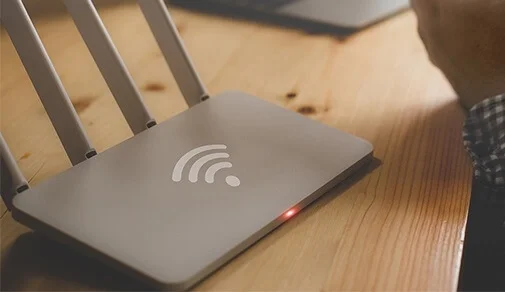
The Internet has taken over a major part of our lives, and we must say for good! Its usage is not limited to just working, studying or entertainment anymore. Now we can buy groceries online, book a cab in a tap and even pay our bills at the comfort of our homes.
The internet is playing an extremely crucial part in our daily lives and no one wants to deal with any kind of glitches. Even with great connection, you find that you can’t catch a signal in certain corners of your home. Thankfully, there is a fix for this and it is as simple as the placement of your Wi-Fi router. Here are some tricks that will help you tackle coverage issues and enhance your internet experience.
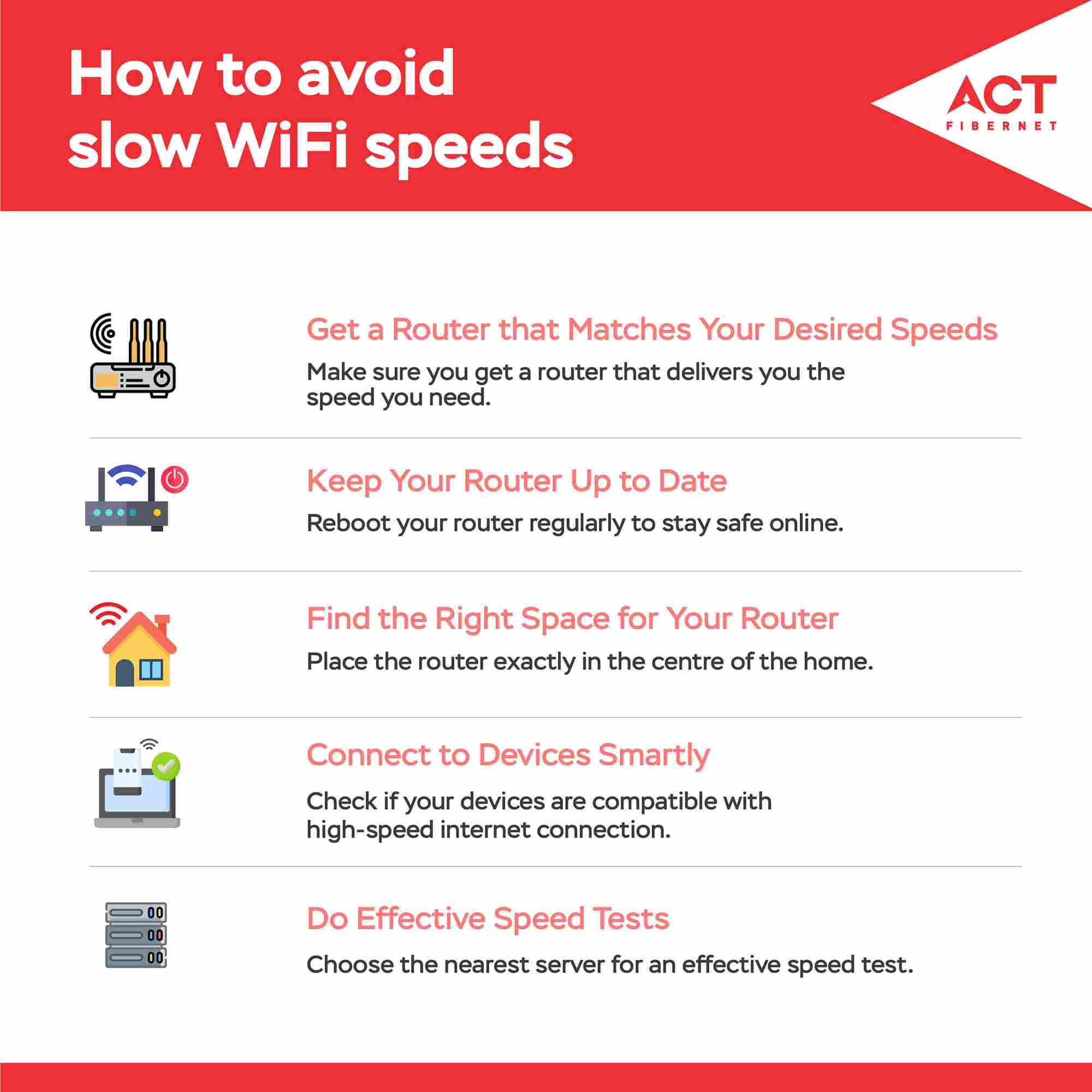
Get a Router that Matches Your Desired Speeds
If you really want to enjoy your internet connection to the fullest, it is important to make sure that your router is capable of delivering the right kind of speed. Check out the table below to know the details:
Keep Your Router Up to Date
With freeloaders all around, it becomes very important to take care of your security and privacy when using a broadband connection. Rebooting your router can effectively help you with the same. Along with that, securing your network with a strong Wi-Fi password and changing it often is an effective way to do it.

offer 24x7 assured speeds?
Connect now to get the best of broadband plans and get additional offers on:
Find the Right Space for Your Router
The placement of your router plays an important part in getting better coverage. Place the router higher above the ground as possible, try to keep it in the middle of your home and away from walls, metal objects and devices like microwaves, TVs etc. as they can interfere with your connection's frequency.
Connect to Devices Smartly
High-speed internet connections need high-end devices that are compatible with them. So check if your device supports 5 GHz band & desired speed. If you still experience slow speeds, then check it by connecting the ACT LAN cable to your laptop or desktop. Also, always keep a check on device if it’s downloading any malware and apply latest security patches to your device.
Do Effective Speed Tests
Whenever you are doing a speed test from your device, keep in mind to close all other online activities, disconnect all other devices from the Wi-Fi and choose the nearest ACT Fibernet server, so that Speedtest can use the entire bandwidth available to you.
Experience Great Speeds Always
There is no way you will get slower speeds unless you have crossed your FUP limit or the connection is being divided since multiple devices are in use. Go through the FAQs to learn in detail about the limits, post FUP speeds and more.
We hope that with the help of these above tips, you will be able to experience amazing and seamless Internet connectivity and fix minor issues by yourself. If some issues persists, then we are just a call away.
Read tips and tricks to increase your wifi speed here
Be Part Of Our Network
All Categories
- BUSINESS INTERNET
- Router
- Internet Security
- Wi-Fi Connection
- Wi-Fi Network
- Internet Broadband
- smartfiber
- Internet Speed
- TV Streaming
- Wifi Connection
- BEST BROADBAND PLANS
- BROADBAND PLANS | 5GHz
- 2.4GHz
- 5GHz frequency
- 5GHz WiFi frequency
- 2.4GHz frequency
- LDRs
- LONG DISTANCE RELATIONSHIP
- ACT Fibernet
- wifi as a service

Find the perfect internet plan for you!
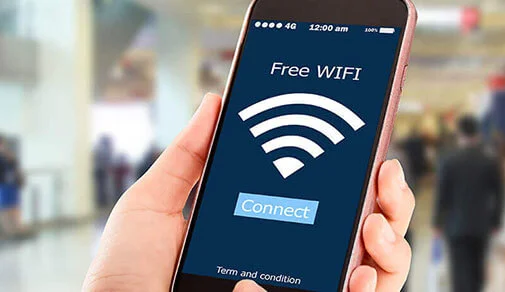
For most individuals in today’s culture, it has become a requirement to stay connected and remain accessible via the Internet always. Whether it is on your phone, laptop, smart watch or tablet, it has become a necessity for you to constantly be connected. Internet mobility and always being online while on the go has increased tenfold in the last few years. People are already accessing the web on the go (smartphones or laptops) in growing numbers as compared to internet accessed by desktops. This proves that individuals are now changing their habits when it comes to internet usage and they are no more restricted to a physical space or desktop to access web. In fact, most individuals want to have instant access right at their fingertips, which is leading to an increase in the number of people who are subscribing to a new internet connection to enjoy fast speeds and faster downloads. We at ACT Fibernet, have feasible internet packages to suit all requirements. We offer broadband services in Hyderabad, Delhi, Bengaluru and many other cities across India.
This article talks about a few interesting facts about Wi-Fi that you have probably not heard of in the past. Keep reading to know further:
Wi-Fi Was Previously Known as WaveLAN
Some of the previous names for Wi-Fi were WaveLAN, IEEE 802.11b Direct Sequence, DragonFly, FlankSpeed, and WECA. After these names, the more consumer-friendly term for Wi-Fi was adopted. The term “Wi-Fi” was coined by Interbrand as a play on words of the term “Hi-Fi” which stands for “High Fidelity”. However, Wi-Fi doesn’t actually stand for anything.
Wi-Fi Networks Can Be Affected by Microwaves
Have you ever wondered why your YouTube video slows down or stops playing when you are heating up that Italian takeout? Wireless devices often lose internet connectivity whenever the microwave oven is running. This happens because the microwave ovens release a massive amount of energy when it's being used, which tend to interfere with your Wi-Fi signal.
 Looking for an internet plans that
Looking for an internet plans that
offer 24x7 assured speeds?Connect now to get the best of broadband plans and get additional offers on:






The Wi-Fi Performance Drops Around Wireless Devices
The performance of a Wi-Fi connection dramatically drops as soon as more devices connect to it. Even though the majority of routers claim that they can support up to 255 devices, in reality, an internet connection becomes nearly unusable at this point. The main problem is bandwidth, which differs from router to router. Another issue is if there are multiple Wi-Fi networks around you, your device may become slow as multiple signals can interfere with the signal’s clarity. We at ACT Fibernet offer most consistent and an unparalleled internet experience through latest technology of fiber broadband.
Wi-Fi Can Travel Great Distances
Majority of the Wi-Fi networks are usually for domestic use, and generally, have a range of around 30m. However, there exist specially developed Wi-Fi networks, which can travel for a whopping 275km! This is made possible by using Wi-Fi range extenders. Another thing that you need to know is that domestic Wi-Fi signal may fall far short of 10 meters if there are any heavy obstacles such as heavy-duty appliances, walls, or electronics running nearby.
Wi-Fi Does Not Affect Health
There exist a common myth that Wi-Fi signals can be harmful to your health over a period of time and need to be shut off when not in use. However, it has been proved that Wi-Fi signals are far safer than mobile phones. There has been no scientific proof of reported illnesses caused due to Wi-Fi signals.
Wi-Fi has made our lives easier and better. It has also played a considerable role in bringing people together no matter what their geographical locations are. Wi-Fi has basically changed the face of the world, and this is not an opinion anymore, it is a fact!
Click here and know about the most effective Wi-Fi plans in Hyderabad!
Read tips and tricks to increase your wifi speed here
Be Part Of Our Network
All Categories
- BUSINESS INTERNET
- Router
- Internet Security
- Wi-Fi Connection
- Wi-Fi Network
- Internet Broadband
- smartfiber
- Internet Speed
- TV Streaming
- Wifi Connection
- BEST BROADBAND PLANS
- BROADBAND PLANS | 5GHz
- 2.4GHz
- 5GHz frequency
- 5GHz WiFi frequency
- 2.4GHz frequency
- LDRs
- LONG DISTANCE RELATIONSHIP
- ACT Fibernet
- wifi as a service

Find the perfect internet plan for you!
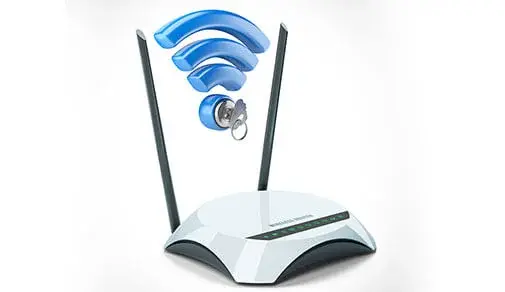
Internet security is an important feature of modern life. No matter how much we’d like to believe that we are immune from hackers, the truth is that anyone who uses the internet is susceptible to attacks that can be malicious. Wi-Fi networks are particularly vulnerable to attacks even if you have secured your network. The good news is that there are several simple steps you can take in order to secure your Wi-Fi connection and the information open to the network.
Stronger Encryption
Make sure that your wireless access point is updated and does not use the old WEP (Wired Equivalent Privacy) security system. This has been proven to be insecure and can be easily hacked by most cybercriminals. Instead, opt for the newer WPA (Wi-Fi Protected Access) in the form of WPA2 or WPA3. Even with this system, it is prudent to use a strong password which is changed frequently, especially if the system is used in an office or commercial setting. Check to make sure that you have deactivated the WPS feature offered by your router. This is also easy to hack even if you are using a WPA system.
Separate network for guests
Offer a guest network so that they can connect to the internet without getting access to your family's internal network. It prevents inadvertent infections of your network with viruses or other malware. You can do this by using a separate internet connection with its own wireless access point. However, this is an unnecessary step since newer consumer wireless routers can run two Wi-Fi networks at once. Turn on the WPA protection for the guest network to have control over who uses it. This also protects your guests from others on the guest network.
 Looking for an internet plans that
Looking for an internet plans that
offer 24x7 assured speeds?Connect now to get the best of broadband plans and get additional offers on:






Hide the Network Name
Networks’ usual default setting is to broadcast its name to make it easy to find and connect to. However, you can hide the name which then requires users to know the name of the network beforehand. Keep in mind that hiding the SSID isn’t a failsafe step in securing your network. Hackers can use Wi-Fi scanning tools to detect your network and hidden SSID. This step gives your Wi-Fi connection a valuable extra layer of protection.
Firewalls
Most routers have hardware firewalls built into them, which are the first line of defense against hackers. They check data coming into and going out of the router and block any suspicious activity. However, you should also consider software firewalls that run on your desktop or laptop. You will get a better idea of what data is passing through the device. You can allow or block any particular program's ability to send and receive data.
Protect with a VPN
VPN or Virtual Private Networks are designed to help secure your online activity and keeping your private search history and activities safe. Simply put, these networks keep your data hidden from prying eyes by encrypting it. In such a case, hackers can go so far as to penetrate your network and be blocked from doing any harm to the system if the VPN is running permanently.
Turn it off when not in use
You can secure your network by disabling your Wi-Fi for home in extended periods of non-use. As simple as this might seem, you are in fact closing any windows of opportunity that malicious hackers might use to get access to your network while you are away. Turning off your network devices minimizes the chances of becoming a target for hackers. It also lowers the possibility of being damaged by electric power surges.
If you are wondering which Wi-Fi providers near me provide a safe, secure, fast, and affordable internet connection, look no further than ACT internet. You can contact ACT via their website or their mobile app. Their crack team of security experts can help you set up a Wi-Fi network that uses the best practices in internet security.
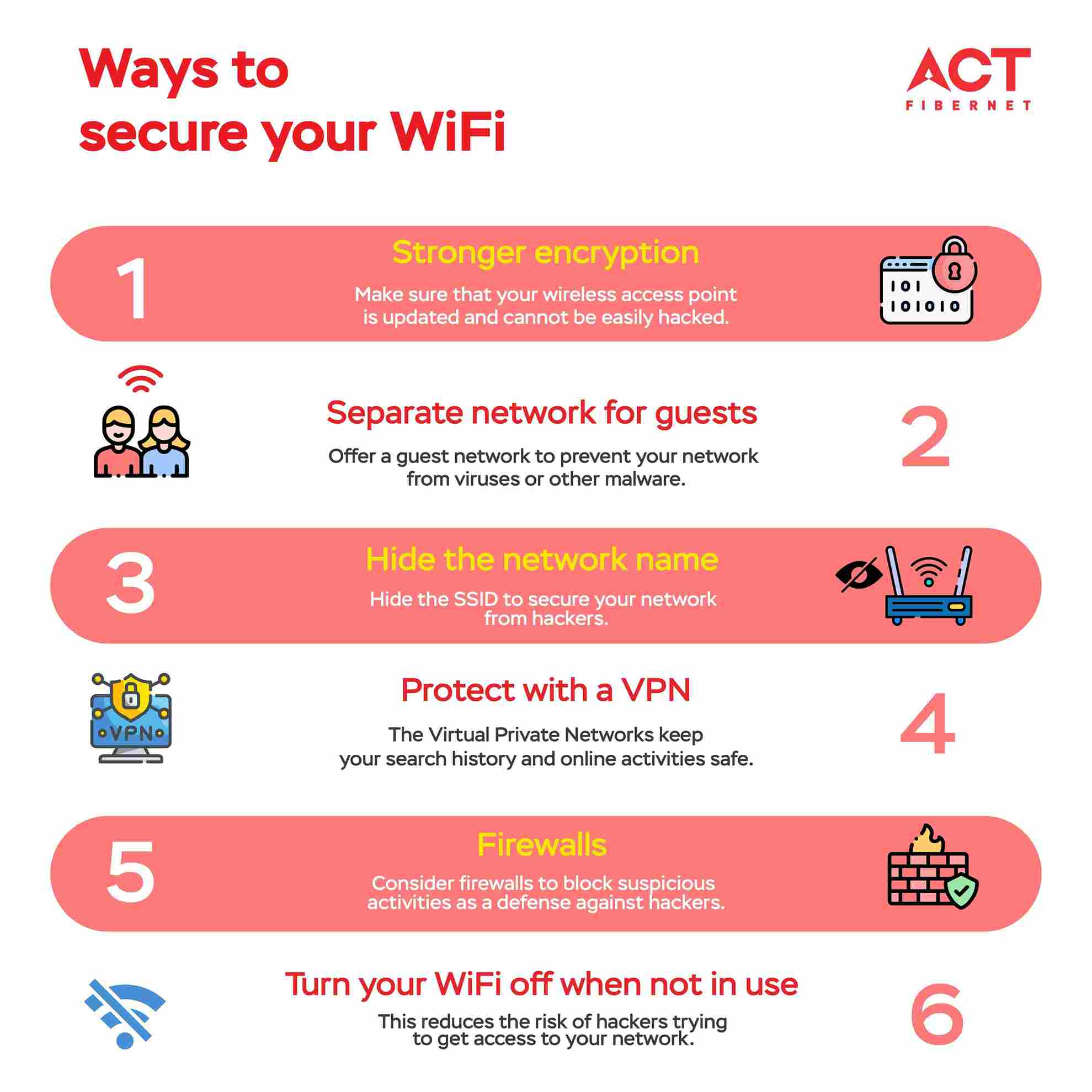
Read tips and tricks to increase your wifi speed here
Be Part Of Our Network
All Categories
- BUSINESS INTERNET
- Router
- Internet Security
- Wi-Fi Connection
- Wi-Fi Network
- Internet Broadband
- smartfiber
- Internet Speed
- TV Streaming
- Wifi Connection
- BEST BROADBAND PLANS
- BROADBAND PLANS | 5GHz
- 2.4GHz
- 5GHz frequency
- 5GHz WiFi frequency
- 2.4GHz frequency
- LDRs
- LONG DISTANCE RELATIONSHIP
- ACT Fibernet
- wifi as a service

Find the perfect internet plan for you!
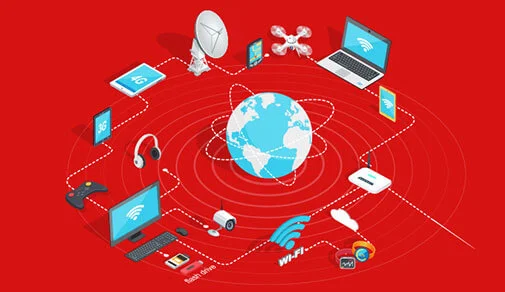
Not a day goes by in our lives without access to the internet, we are addicted to it for simplest of things from entertainment to banking. While the internet has definitely bridged the knowledge gap between developed and developing countries, wireless internet has made this digital experience a reliable, uniform, and seamless entity. A new generation of innovation pertaining to Smart Devices, Internet of Things & Augmented/Virtual Reality has changed the way people consume internet. Our current internet consumption patterns in India are exploring merely the tip of the iceberg. There's a lot to explore between "purchasing an internet connection" to "making technology work for you".
So, let's delve deeper into making the most out of your wireless internet with the 5 most useful wireless gadgets available in India, which can simplify our lives:
Smart Home Tools:
Wireless Internet has enabled the use of smoke detectors, smart lights, burglar alarm system, video door phones, CCTV, electronic lockers, and smart entertainment systems. This means that while you are away at work, your home is completely secure and these systems will report any inconsistencies directly to your mobile. Additionally, during your commute back home, you can set your room temperature, record Live TV as you missed the live telecast of the big game, turn on the bathroom geyser for a warm shower, and set the room lights to your mood from a simple mobile app.
Smart Printers:
With so many devices connected to the internet in a single household, the need for a wireless printer is imminent. It not only connects wirelessly, but you can also send print jobs to it from a remote location outdoors. On the other hand, many companies have started using wireless 3D printers for digital modeling of the design and testing phase of their products before market launch. This has substantially reduced their R&D costs, as they can in-house manufacture, experiment and experience their product at a fraction of the actual production cost.
Smart Glasses:
Do you remember the excitement of watching your first 3D movie in a theatre? The trends are quickly changing as terms like Virtual Reality & Augmented Reality is becoming commonplace. Both of these cutting-edge technologies change the way we perceive and interact with our own surroundings. While Google Glass is anticipated to resume production by the end of this year. There are a few companies selling smart glasses in India fitted with a high-quality camera to capture HD quality images and videos. The astounding success of Pokemon Go on one hand and the hundreds of listings of "affordable VR glasses" selling in India across various e-commerce platforms is an indication that we are ready to embrace both of these new technologies with aplomb.

offer 24x7 assured speeds?
Connect now to get the best of broadband plans and get additional offers on:
Health Monitoring:
Not just the fitness freaks/health enthusiasts, wearable fitness devices are being used by people across age groups irrespective of whether they are appropriately using it or not. These devices have become a fashion statement and can not only track your daily activities, sleep patterns, and calorie intake but also suggest you exercises, improvement techniques, and monitor your vital signs on-the-go. There are plenty of devices like smart bands, fitness trackers, portable air-purifiers, pocket-friendly health diagnostic systems for Blood Pressure/Heart Rate/Sugar etc that are in popular demand. Even if you do not want to purchase a device, there are plenty of fitness apps that can be used for similar purposes and be refined to meet your needs. So, next time you forget to drink 3 Litres of water day, simply download an app and never stay dehydrated again.
Real-Time Services:
In the last decade, one of the biggest advantages of using wireless internet has been the mushrooming of real-time services. While Google & Facebook are tech giants leading the world with their real-time services like Maps & Crisis Response (Mark yourself safe) respectively, there has been a surge in the number of innovative start-ups catering to this market. Even mobiles are using Apple Cloud & Google Drive to take backup on the cloud. Apart from the cloud storage, real-time remote collaborative systems are increasingly being used for documentation, real-time chat, project management, resource scheduling, testing/ticketing status, event planning, and message boards. Tracking your e-commerce shipments is one such common use of these real-time services.
We are riding on this new tide called internet which has already leaped beyond conventional devices (laptops and smartphones). These smart devices not only improve our quality of life but also increase our productivity. In a nutshell, we are heading towards smart cities, smart homes, connected cars, connected healthcare, and basically a unified automated world. Most of these aspects are already available in one form or another. We already have GPS tracking enabled and Live Maps integrated Connected Cars. The dream of Digital India has already shouldered a brave step towards the creation of Smart Cities across the nation. In the times to come, India will also witness urban development in tune with IoT & ICT. This will enable growth of self-sustainable cities that have sensors for ensuring integrated infrastructure, communities, law enforcement, energy management, transportation etc.
The time has come to utilize the world of internet as a gateway to opportunities, skill development, commerce, knowledge sharing, community building, and individual economic growth. And, wireless internet is the key to unlock the true potential of the internet.
Read tips and tricks to increase your wifi speed here
Be Part Of Our Network
All Categories
- BUSINESS INTERNET
- Router
- Internet Security
- Wi-Fi Connection
- Wi-Fi Network
- Internet Broadband
- smartfiber
- Internet Speed
- TV Streaming
- Wifi Connection
- BEST BROADBAND PLANS
- BROADBAND PLANS | 5GHz
- 2.4GHz
- 5GHz frequency
- 5GHz WiFi frequency
- 2.4GHz frequency
- LDRs
- LONG DISTANCE RELATIONSHIP
- ACT Fibernet
- wifi as a service

Find the perfect internet plan for you!

Our houses are now packed with a variety of gadgets and equipment that require an internet connection, thanks to our increasingly modern environment. Our increased reliance on the internet to link all of our devices, whether it's our computer, tablet, phone, fridge, TV, or baby monitor, has opened the door to various threats and security issues.
Hackers are opportunistic, waiting to exploit any security flaw to launch a targeted assault. Hackers can steal personal and financial information, infect your devices with viruses and malware, commit cybercrime from your device, or launch a Distributed Denial of Service (DDOS) attack if they obtain access to your home network.
Top Tips To Protect Your Home Wi-Fi Network
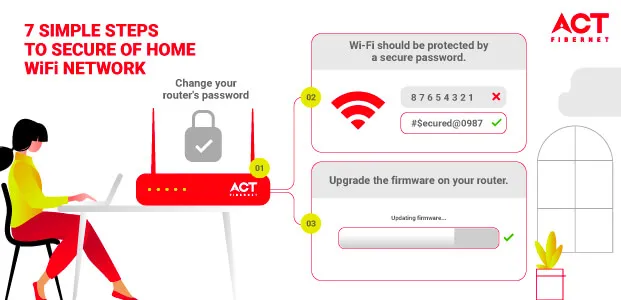
Change your router's password.
Any novice with even the most basic technical knowledge can gain access to your router's admin panel. You should start by protecting your router's software to prevent your Wi-Fi from freeloaders who use your Internet without your permission. Make sure you login to your router's admin panel and modify the defaults before you connect it to the Internet.
Most users can access the admin panel by typing http://192.168.1.1 in the address bar of their browser. This is the router's default IP address, if it doesn't work, it might be 192.168.0.1 or 192.168.2.1 based on the manufacturer of your router. The default username and password should be listed in your router's documentation, on a sticker on the side of your router. Many IoT devices get hacked due to use of default passwords.
Wi-Fi should be protected by a secure password.
While this may seem self-evident, many individuals are still unaware that any password that is easy to guess (such as your name, phone number, or date of birth) is the reason why your neighbours are frequently the first to use your Wi-Fi without your awareness. Despite the fact that we are more dependent on the Internet than ever before, the most frequent password is still '123456.'
If you have to share your Wi-Fi password with friends or acquaintances, make sure you change your password afterwards. Periodically changing your password might sound like a task because you will need to login again from all of your devices, but the biggest advantage it serves is that every time you reset it, you reset the number of people who can connect to your network back to one - only you.
Upgrade the firmware on your router.
Firmware is the software that is embedded in your router and regulates how it functions. If you're having trouble with your wireless signal, changing the firmware on your router could cure your problems and provide steady connectivity. Check your router's firmware for any available upgrades on a regular basis to take advantage of the newest security fixes and safety enhancements.
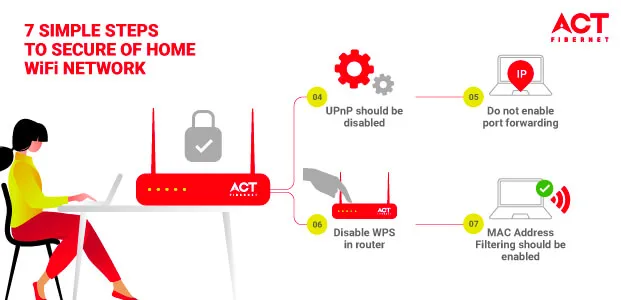
UPnP should be disabled.

offer 24x7 assured speeds?
Connect now to get the best of broadband plans and get additional offers on:
Because it bypasses your network's firewall and assumes some programmes are trustworthy, Universal Plug and Play (UPnP) poses a security risk. Essentially, as the name implies, it lets users plug in a device and immediately begin using it without having to configure it. A network printer, for example, can be accessible by any device on the network without the need for the printer to be installed on the device. Unless you often use P2P apps, gaming servers, or VoIP services, you should disable UPnP. Simply Google "disable UPnP" followed by the name of your router manufacturer to find out how to disable UPnP.
Do not enable port forwarding
Generally, in any router port forwarding is turned off by default. The router uses it to route network requests via IP to specific devices on the network also bypassing the network firewall. Unless you have an absolute need for it, like if you are using a CCTV camera, you should keep port forwarding disabled. Because after you connect to the Internet, by default your external IP address is shared in the public domain. In case, port forwarding is enabled then the same connection can be hacked by anyone. You can disable port forwarding from the admin panel of your router.
Disable WPS in router
Wi-Fi protected set-up or WPS works similarly to UPnP and is likely to be enabled by default. It was devised to be used as a secure and faster way to connect a router to wireless devices. However, in recent years, loopholes have been discovered. Thus, it was found that it made users susceptible to hacking, especially those on personal Wi-Fi. Ever since it has been repeatedly advised to simply turn off the WPS from your router's admin panel.
MAC Address Filtering should be enabled.
The physical address, also known as the Media Access Control (MAC) address, is a unique identification found on most broadband routers. By limiting the number of devices that can connect to the home network, this address tries to increase security. The MAC addresses of all devices in the residence can be typed in by homeowners, which restricts the network.
When it comes to keeping criminals out and protecting your data, securing your home network is critical.
Read tips and tricks to increase your wifi speed here
Be Part Of Our Network
All Categories
- BUSINESS INTERNET
- Router
- Internet Security
- Wi-Fi Connection
- Wi-Fi Network
- Internet Broadband
- smartfiber
- Internet Speed
- TV Streaming
- Wifi Connection
- BEST BROADBAND PLANS
- BROADBAND PLANS | 5GHz
- 2.4GHz
- 5GHz frequency
- 5GHz WiFi frequency
- 2.4GHz frequency
- LDRs
- LONG DISTANCE RELATIONSHIP
- ACT Fibernet
- wifi as a service

Find the perfect internet plan for you!
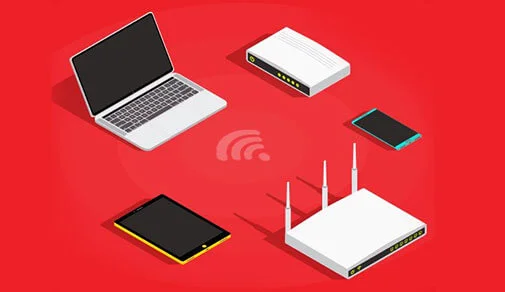
Do you struggle to find Wi-Fi signal within your own house, searching around rooms only to find zero or poor internet connection in many areas. Are you afraid to even imagine the problems associated by using a single router across a multi-storey house?
Despite spending a substantial amount on best internet speed plans and the best router, it gets frustrating when your Wi-Fi doesn't work like you expect it to. Have you ever wondered, this could be due to the incorrect placement of your router?
Let us get our facts right, the strength of your Wi-Fi signal is hugely dependent on the router placement. So, choosing the right spot to place your router can be as equally important as choosing which router to buy. This way you can increase internet speed without spending extra on your monthly plan. Some minor adjustments in the router placement, can help you get rid of your Wi-Fi woes:
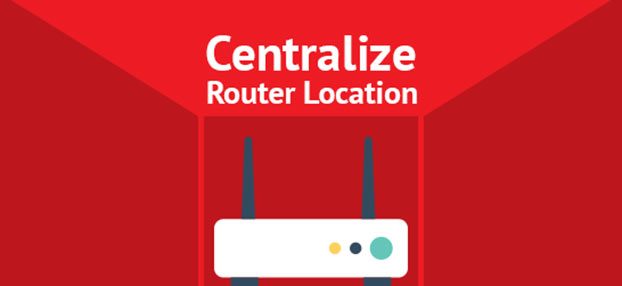
1. Centralize Router Location:
For increasing coverage area, try to place your wireless router in the middle of your home and enjoy uniform signal strength across all rooms. If you are worried about hanging wires spoiling the aesthetics around your living area, the right solution is not to hide the router away, rather enclose those wires.

2. Out of Sight, Out of Range:
The router should always be placed in a spot where you can see it, so it is always better to put it on the shelf/ mount on a wall rather than keeping it inside a cupboard. Commonly, people are forced to install their routers in the room where wireline connection comes into their house irrespective of where they actually need the signal. If it is possible, place your router as close to the users for best Wi-Fi signal strength. Placing the router in plain sight can boost its signal by 2x compared to hiding the router in a closet ensuring you fully utilize your internet speed.
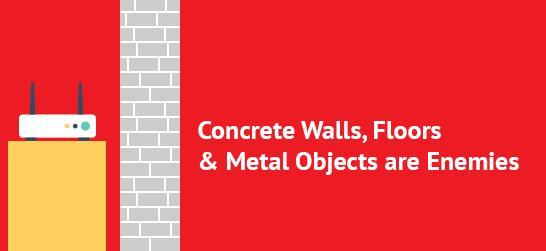
3. Concrete Walls, Floors & Metal Objects are Enemies:
All these three are known to interfere with wireless signals, the closer your router is to any of these, slower your Wi-Fi signal strength will be. Thick walls are one of the key reasons why you get weak signal inside rooms. While it is unavoidable to get rid of all three, you need to select a spot with least interference. Also, metal and mirrors reflect radio waves. For instance, you can choose a spot by reducing the number of walls the signal has to cross, avoid placing it near any metal objects especially a microwave or TV or cordless phone base station or even a metal door. Placing the router near a window will result in some of the signal going outside. Water bodies such as fish-tanks can also interfere with radio signals.

offer 24x7 assured speeds?
Connect now to get the best of broadband plans and get additional offers on:

4. The Higher The Better:
Wi-Fi signals go down as well as up, so if you put it on the floor, a proportion of the signal will traverse down. Thus, you must avoid putting it on the floor. It is better to put the router higher up (on a shelf/mounted on a wall) to get better coverage. So, if you own a multi-storey home it is advisable to place the router higher up near the roof for coverage across both floors.

5. Antenna Position is Critical:
For a better horizontal reach, position your router's antenna slightly upwards or sideways for vertical reach. One common thing to remember is to not put the antenna in the direction of a wall or other obstacle and do not position the antenna at 90 degrees. The recommended angle is between 45 to 60 degrees. If your router has 2 or 3 antennas you can point each of those in a different direction and angle to evenly spread the range across your home.
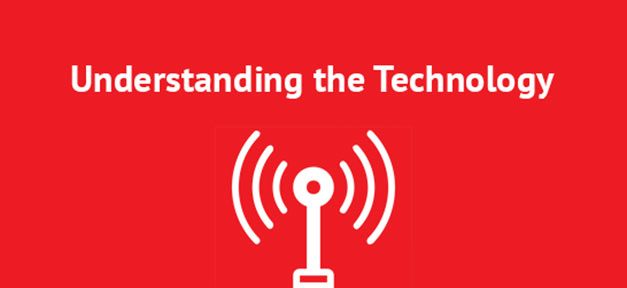
6. Understanding the Technology:
As you may be aware, Wi-Fi router delivers wireless internet to devices using radio waves and manages the network traffic. This is just like tuning in to your favourite FM radio station, where you cannot connect if the radio signal is weak because you are out of range. Simply put, the farther your devices are from the router, the weaker the signal strength will be and thus the network speed will be slower. A typical 3.5 inch brick wall, 2 inches of marble and a 1.75 inch solid wood door will all attenuate a 2.4 GHz Wi-Fi signal by 50 percent. So, obstacles around your house can lead to 75 percent reduction in signal strength within a close proximity of 100 meters. Understandably, this is why you get zero signal strength in the room farthest away from the router.
Sometimes the interference may occur only at certain times of the day. This could be due to external reasons outside your house. For instance, when neighbor turns on their router or cordless on a certain time during the day. With ever increasing number of connected devices, in today's time and age, you cannot have an interference-free environment. But, you can still opt for least interference and congestion with some minor adjustments to your router placement.
That's My Spot:
Just like Dr. Sheldon Cooper, you need to be extremely careful while choosing the right spot for your Wi-Fi router. Once you find that coveted spot, you can finally enjoy the best internet speed, at your convenience, tucked away in the remotest corner of your house.
Read tips and tricks to increase your wifi speed here
Be Part Of Our Network
All Categories
- BUSINESS INTERNET
- Router
- Internet Security
- Wi-Fi Connection
- Wi-Fi Network
- Internet Broadband
- smartfiber
- Internet Speed
- TV Streaming
- Wifi Connection
- BEST BROADBAND PLANS
- BROADBAND PLANS | 5GHz
- 2.4GHz
- 5GHz frequency
- 5GHz WiFi frequency
- 2.4GHz frequency
- LDRs
- LONG DISTANCE RELATIONSHIP
- ACT Fibernet
- wifi as a service

Find the perfect internet plan for you!


